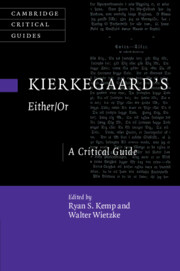Book contents
- Kierkegaard’s Either/Or
- Cambridge Critical Guides
- Kierkegaard’s Either/Or
- Copyright page
- Contents
- Contributors
- Acknowledgments
- Abbreviations
- Introduction
- Chapter 1 Existential Melancholia
- Chapter 2 Don Giovanni and the Musical-Erotic
- Chapter 3 For What May the Aesthete Hope?
- Chapter 4 Companions in Guilt
- Chapter 5 A’s Religion of Boredom
- Chapter 6 The Artist Is Not Present
- Chapter 7 Failed Temporalities in Either/Or
- Chapter 8 Love, Marriage, and Delusion in Either/Or
- Chapter 9 The Philosophy of Science in Either/Or
- Chapter 10 The Despair of Judge William
- Chapter 11 The Problem of Evil in Either/Or
- Chapter 12 Illusions of Ethical Independence
- References
- Index
- Cambridge Critical Guides
Chapter 11 - The Problem of Evil in Either/Or
A Religious–Aesthetic Debate
Published online by Cambridge University Press: 16 November 2023
- Kierkegaard’s Either/Or
- Cambridge Critical Guides
- Kierkegaard’s Either/Or
- Copyright page
- Contents
- Contributors
- Acknowledgments
- Abbreviations
- Introduction
- Chapter 1 Existential Melancholia
- Chapter 2 Don Giovanni and the Musical-Erotic
- Chapter 3 For What May the Aesthete Hope?
- Chapter 4 Companions in Guilt
- Chapter 5 A’s Religion of Boredom
- Chapter 6 The Artist Is Not Present
- Chapter 7 Failed Temporalities in Either/Or
- Chapter 8 Love, Marriage, and Delusion in Either/Or
- Chapter 9 The Philosophy of Science in Either/Or
- Chapter 10 The Despair of Judge William
- Chapter 11 The Problem of Evil in Either/Or
- Chapter 12 Illusions of Ethical Independence
- References
- Index
- Cambridge Critical Guides
Summary
Judge William of Kierkegaard’s Either/Or claims that the Jutland Pastor’s sermon expresses exactly what he had tried to say in his letters. This is far from obvious to the reader, and I suggest we bypass the Judge, reading the sermon directly with A’s essays on unhappy love and tragedy. Like the sermon, Part I’s “Shadowgraphs” deals with the psychology of persons who have (apparently) been wronged by someone they love and the defenses they construct on the beloved’s behalf mimic classic theodicies. The Pastor’s “practical theodicy,” which consists in thinking of ourselves as the wrongdoers, can be applied to their predicament as well. Yet imagining what that would mean in an abusive interpersonal relationship shows how perilous the Pastor’s theodicy is, alienating us from our own ideas of good and bad, right and wrong. A’s treatment of tragedy offers an alternative. Recognizing that God (or the beloved) is indifferent or simply evil restores our moral-emotional integrity.
Keywords
- Type
- Chapter
- Information
- Kierkegaard's Either/OrA Critical Guide, pp. 188 - 203Publisher: Cambridge University PressPrint publication year: 2023

